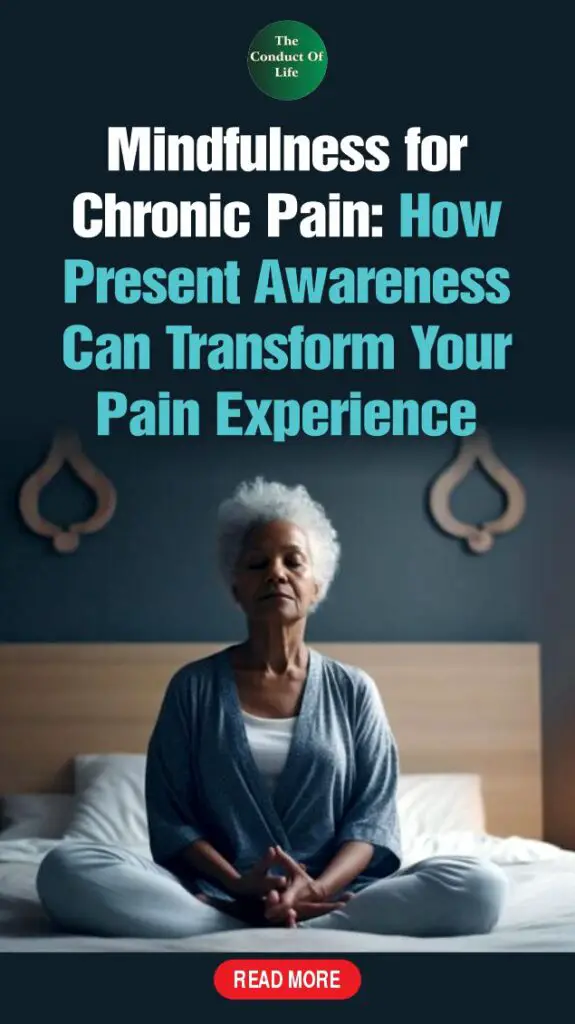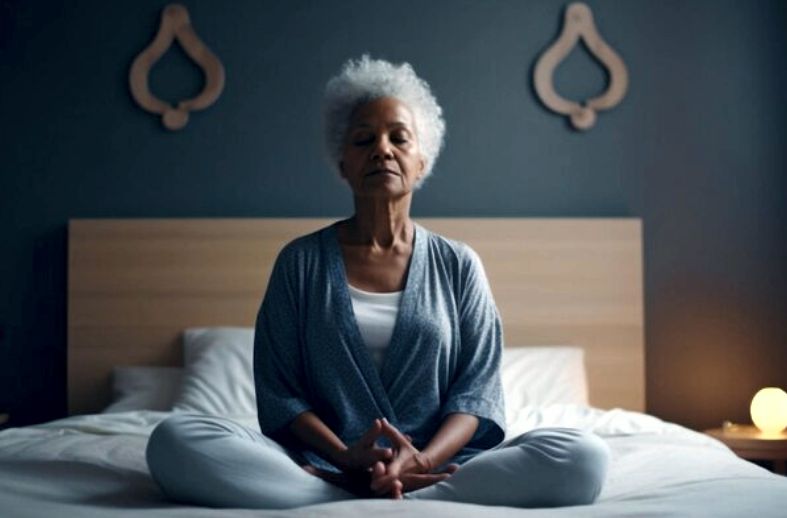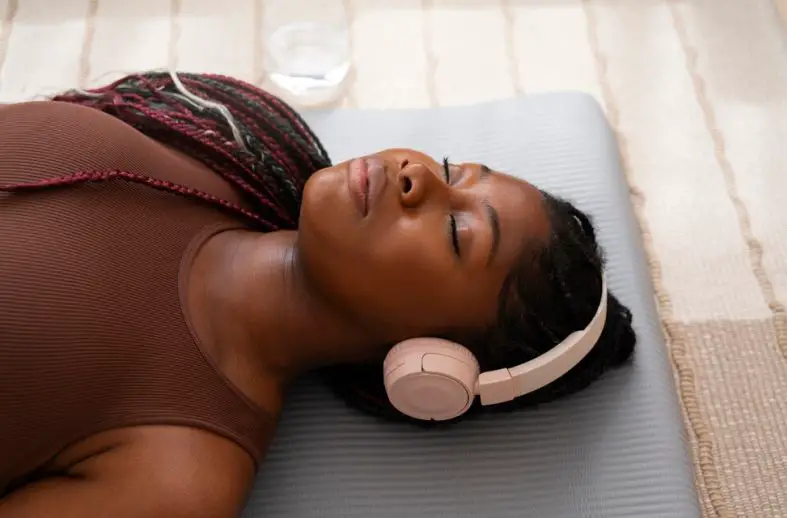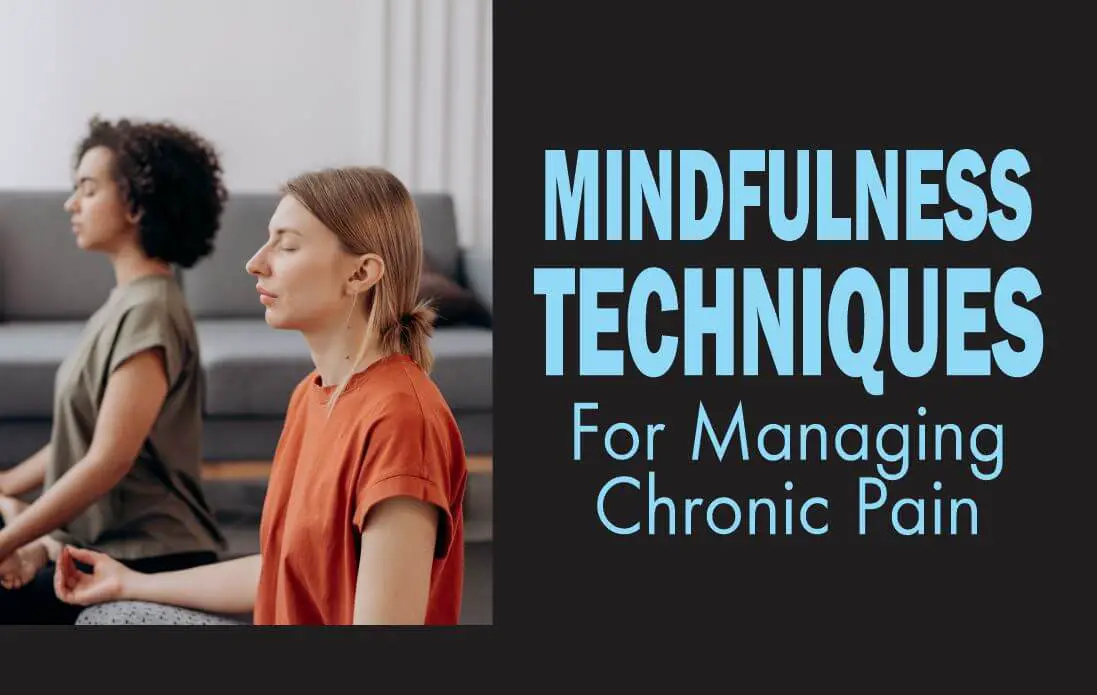Last updated on December 7th, 2025 at 06:55 pm
Discover how mindfulness for chronic pain can transform your relationship with pain. Learn science-backed techniques and real-life practices to ease suffering naturally.
You live with a pain that doesn’t go away. Some days it’s dull, other days it’s sharp, but it’s always there, shaping how you move, think, and feel.
Medications may offer short breaks, but the side effects and the constant chase for relief wear you down.
You’re not alone. Chronic pain has a way of isolating people, not just physically but emotionally.
According to the National Institutes of Health, chronic pain affects approximately 20% of adults in the United States.
That’s where mindfulness comes in: not as a miracle fix, but as a skill you can build.
It teaches you to pay attention to your body without reacting to every sensation. Instead of fighting pain, you observe it.
Think of Emerson’s idea, living in rhythm with what is. Mindfulness gives you a moment of space.
In that space, you might find something you didn’t expect: control, even in the middle of discomfort.
In this blog post, we will equip you with valuable tools and insights on how to utilize mindfulness as a pragmatic approach to managing chronic pain.

Table of Contents
- Understanding Chronic Pain: Beyond the Physical
- Why Traditional Pain Management Falls Short
- How Mindfulness Works for You
- The Science Behind Mindfulness and Chronic Pain
- Emerson’s Quiet Influence: Listen to Pain Instead of Fighting It
- Shift Your Mindset: Pain Isn’t Your Enemy
- Practical Mindfulness Techniques for Chronic Pain
- Creating a Mindfulness Routine That Works for You
- Mindfulness vs Avoidance: Embracing Discomfort with Compassion
- Frequently Asked Questions
- Conclusion
Understanding Chronic Pain: Beyond the Physical

You know your pain isn’t just in your body. It lingers past the injury or illness, sometimes without a clear cause.
Chronic pain lasts more than three months. It doesn’t always follow a pattern, and it doesn’t always make sense. But it’s real, every single day.
Why It Feels Like More Than Just Pain
Chronic pain doesn’t behave like acute pain. Acute pain warns you of danger and helps you heal.
Chronic pain stays long after the healing should be done. It can show up through conditions like arthritis, fibromyalgia, or nerve damage.
But even when doctors can’t find a reason, the pain still takes over your daily life.
Pain like this can change how you feel, think, and interact with others.
That’s why experts look at it through the biopsychosocial model.
This model explains how your body, mind, and social life all shape your pain experience.
How Your Mind Affects Your Pain
You might notice that pain feels worse when you’re anxious, stressed, or down.
That’s not in your head, it’s how the brain and body talk to each other.
When your mood drops, pain sensitivity can rise.
And the longer you feel stuck in that loop, the harder it becomes to break free.
The Role of Social Support and Environment
Your environment matters too. When you feel heard, supported, and respected, pain can become easier to manage.
But if people dismiss your pain or if resources are limited, it gets harder.
Loneliness, pressure, or judgment can all increase your stress and make pain feel more intense.
Why This Matters for Mindfulness
Understanding this full picture helps you see why medication alone might not work.
It’s not just about the pain in your body, it’s about everything around and within you.
That’s where mindfulness becomes useful. You learn to observe your pain without reacting to it, building space between sensation and suffering.
That space is where you begin to take back control.
Related Posts
- Mindfulness Techniques For Better Sleep And Relaxation
- Mindfulness Meditation Techniques For Beginners
- How Adults Can Practise Mindfulness
- What Are The Seven Pillars Of Mindfulness?
- How Can Mindfulness Help In The Workplace?
Why Traditional Pain Management Falls Short

If you’ve relied on medication for pain relief, you know the pattern.
Drugs like opioids or NSAIDs may ease discomfort at first, but the effects wear off.
You might need stronger doses, and the side effects, like fatigue, stomach issues, or dependency, can make things worse.
Surgeries and nerve blocks can bring short-term relief, but often miss the deeper causes.
Pain isn’t only physical. It’s tied to stress, thoughts, and daily habits. When treatment targets symptoms but not the patterns behind them, real change is hard to find.
Mindfulness and other non-drug approaches offer a different path.
Instead of masking pain, they help you change how you relate to it, calmly, moment by moment.
How Mindfulness Works for You
Mindfulness helps you build a new relationship with pain. Instead of reacting to every ache or flare-up, you start noticing what’s going on.
You begin to see pain as something you have, not something you are.
Here’s how it can help:
Present Awareness
You train your mind to focus on right now. Not the pain from last week. Not the fear of it getting worse tomorrow. Just this moment.
That might sound simple, but it can break the cycle of anxious thinking that often comes with chronic pain.
Start by doing this:
- Sit quietly and notice your breath
- Bring your attention to the sensations in your body
- When your mind drifts (and it will), gently return to your breath
You’re not pushing pain away. You’re just seeing it as it is, without layering it with fear or frustration.
Acceptance Without Giving Up
Acceptance means saying, “This is what I’m feeling right now,” without fighting it.
That doesn’t mean you’re okay with being in pain or that you stop looking for treatment.
It means you stop adding more tension on top of what already hurts.
Try this when pain rises:
- Name it without judgment: “This is tightness,” or “This is throbbing.”
- Notice any thoughts trying to resist the pain
- Let the thoughts pass instead of fueling them
This small mental shift can calm your nervous system and reduce emotional stress around the pain.
You Are Not Your Pain
When pain is always with you, it’s easy to let it shape your identity. But mindfulness helps you see the difference between you and the pain.
You can think:
- “Pain is part of my day, not all of me.”
- “I can notice this moment and still have a life beyond pain.”
You’re still you, the person who laughs at old movies, enjoys music, and cares deeply about others.
Mindfulness gives you space to reconnect with those parts of yourself again.
Try This: A Simple Body Scan for Pain Awareness
Here’s a short practice to start with:
- Lie down or sit comfortably
- Close your eyes and take a few slow breaths
- Bring your attention to your toes. Notice any sensation—warmth, tingling, or nothing at all
- Slowly move up through each part of your body, staying present with the sensations
- If you feel pain, just notice it. No fixing. No fighting
This can take 5 minutes or more. Do it at your own pace.
Mindfulness won’t cure your pain. But it can change how much space it takes up in your mind.
It can help you sleep better, reduce anxiety, and give you tools to face each day with more calm.
If you’re dealing with conditions like fibromyalgia, arthritis, or back pain, mindfulness can work alongside other pain management tools. Think of it as another layer of support.
The Science Behind Mindfulness and Chronic Pain
If you live with chronic pain, you’ve probably tried a mix of treatments. Some help. Some don’t.
But what if training your mind could help ease the way you experience pain?
That’s where mindfulness comes in, and science backs it up.
For example, a study published in the Journal of Pain found that mindfulness-based stress reduction (MBSR) was effective in reducing pain severity and improving the quality of life in individuals with chronic pain.
Another example, a study published in the Journal of Psychosomatic Research found that mindfulness-based stress reduction was effective in reducing anxiety and depression in individuals with chronic pain.
Another study published in the Journal of Behavioral Medicine found that mindfulness meditation was effective in reducing pain intensity and unpleasantness in individuals with chronic low back pain.
What Research Says About Mindfulness and Pain
One name comes up a lot in this field: Jon Kabat-Zinn. He created the Mindfulness-Based Stress Reduction (MBSR) program, a structured way to use mindfulness to manage pain and stress.
People with conditions like fibromyalgia, arthritis, back pain, and migraines have gone through MBSR, and the results are promising.
Studies show that mindfulness practice can lower how intensity of pain feels.
Even more importantly, it can reduce the mental and emotional stress that pain brings with it.
So, while mindfulness doesn’t get rid of the pain, it helps you deal with it in a way that feels lighter.
What Happens in Your Brain When You Practice Mindfulness
Brain scans reveal something interesting: mindfulness changes how your brain works, especially in areas linked to pain and emotions.
Prefrontal Cortex
This part of your brain helps you make decisions and regulate emotions.
When you practice mindfulness meditation regularly, activity in the prefrontal cortex increases.
That means you may gain more control over how you respond to pain, rather than reacting automatically with fear or frustration.
Amygdala
Your amygdala gets activated when you’re scared or stressed.
For people with chronic pain, it tends to stay in high alert mode. But mindfulness seems to calm it down.
A quieter amygdala means less anxiety, which can make pain feel more manageable.
Anterior Cingulate Cortex
This area is tied to both pain and emotional processing. Research shows that with consistent mindfulness training, it starts to shift, too. That shift can make pain feel less overwhelming.
These brain changes are known as neuroplasticity. In simple terms, your brain rewires itself based on what you practice.
So, practicing mindfulness regularly may reshape how you process pain, literally.
How This Helps You
Here’s what it boils down to:
- You start to notice pain without drowning in it
- You create space between sensation and reaction
- You build resilience by facing pain instead of avoiding it
This doesn’t mean you stop other treatments. Mindfulness works best when it’s part of a bigger pain management plan.
But it gives you a tool you can use every day, no prescription needed.
Emerson’s Quiet Influence: Listen to Pain Instead of Fighting It
You’ve been taught to fight pain. To push through it, numb it, or ignore it. But what if you stopped fighting? What if you simply listened?
Ralph Waldo Emerson, known for his thoughts on self-reliance and nature, believed in observing life as it is, without rushing to fix or resist.
When you apply that mindset to pain, especially chronic pain, something changes.
Shift Your Mindset: Pain Isn’t Your Enemy

Instead of seeing pain as a threat, try viewing it as part of you. Not something broken or wrong, but something speaking.
Emerson’s quote, “Adopt the pace of nature: her secret is patience,” challenges you to slow down and pay attention.
Like weather patterns or growing trees, pain has its rhythm. You can’t force it away, but you can learn from it.
Use Mindful Observation
Rather than pushing discomfort aside, pause. Notice how your body feels. Ask yourself:
- Where is the pain coming from
- When does it grow louder
- What quiets it, even a little
This is a mindful observation. It helps you understand your pain without fear. You’re not helpless. You’re aware.
Find Patterns in Your Experience
When you observe pain instead of reacting to it, patterns start to show. Maybe your shoulders tense before your lower back flares.
Maybe stress makes things worse. These clues matter. They let you respond, not just react.
This approach is rooted in Emerson’s idea of self-reliance. You’re not chasing quick fixes. You’re listening to your own body.
You’re using what you learn to make better choices.
Acceptance Doesn’t Mean Giving Up
Listening to pain doesn’t mean you stop seeking relief. It means you stop fighting your body like it’s your enemy.
You permit yourself to feel without judgment. That’s not weakness, it’s awareness.
By observing instead of resisting, you may notice brief moments when the pain eases. You may also spot what triggers it or what helps.
Each discovery gives you more control, not over the pain itself, but over your response to it.
Let Pain Teach You
Emerson’s ideas push you toward a quiet strength: one where you’re not defined by pain, but informed by it.
You learn to trust your inner wisdom. You become less afraid.
So next time the pain returns, don’t brace for a fight. Breathe. Listen. Let it speak. You might be surprised by what it tells you.
Practical Mindfulness Techniques for Chronic Pain

Living with chronic pain can wear you down, physically and mentally. But mindfulness gives you a way to shift how you relate to it.
Instead of trying to push pain away, you start to notice it with less judgment and more awareness.
These mindfulness techniques are simple enough to try today and powerful enough to help you manage pain from the inside out.
Body Scan Meditation: Tune In Instead of Tuning Out
Find a quiet place. Lie down or sit comfortably. Close your eyes.
Now, bring your attention to your toes. What do you feel? Warmth? Tingling? Nothing at all?
Whatever it is, just notice it. Then move to your feet, ankles, legs, slowly work your way up to your head.
Don’t force anything. You’re not trying to fix pain or tension. Just observe. This is body scan meditation.
It helps you listen to your body without panic or pressure. You’ll start to spot where tension gathers and where relief lives.
Breath Awareness: Anchor Yourself in the Present
When pain takes over, your thoughts tend to spiral. Breath awareness helps you find your footing again.
Sit upright or lie back. Rest your hands on your belly. Inhale slowly through your nose.
Exhale through your mouth. Feel the rise and fall of each breath.
Your breath is always with you. Use it. Each time your mind drifts to pain or stress, come back to your next inhale.
Over time, this can reduce anxiety and help you stay calmer through the waves of discomfort.
Mindful Movement: Let Your Body Guide You
You don’t have to be flexible or fit. Mindful movement is about moving with intention, not intensity.
Try this:
- Stretch gently in the morning
- Practice a few yoga poses
- Walk slowly and focus on each step
Notice how your body responds. Pay attention to any changes in tension or ease.
Mindful movement builds a better connection with your body. It also helps with circulation, stiffness, and mood.
Loving-Kindness Meditation: Be on Your Own Side
Chronic pain can wear away your self-talk. You may start blaming yourself or feeling stuck. That’s where loving-kindness meditation comes in.
Sit quietly. Repeat simple phrases in your mind:
- May I be safe
- May I be strong
- May I be at peace
Say these with intention. Then extend them to others, someone you care about, someone neutral, even someone difficult.
This builds emotional resilience and softens the inner tension that pain can create.
Mindful Journaling: Put Pain into Words
Sometimes, pain gets worse when it stays in your head. Writing can help.
At the end of the day, jot down:
- What did you feel physically
- What made it worse or better
- How you responded emotionally
Over time, you’ll see patterns, like triggers, cycles, or thoughts that make pain harder.
This gives you a map of your experience, and that map can help you move through it with more awareness and less fear.
Creating a Mindfulness Routine That Works for You

If you’re living with chronic pain, setting up a daily mindfulness practice can help you respond to discomfort with more calm and awareness.
You don’t need to force long sessions or expect quick changes. Start small and build from there.
Start with Short Sessions
Give yourself just two to five minutes each day. Sit in a quiet space.
Focus on your breath or on how your body feels.
Let your attention rest gently on the present moment. You’re not trying to control your pain.
You’re learning how to stay with it without judgment. As this becomes easier, you can slowly extend the time.
Use Guided Tools for Support
Mindfulness apps can help if you feel unsure where to begin. Tools like Headspace, Calm, or Insight Timer offer guided meditation for pain and stress.
These apps include daily reminders and programs built for chronic pain relief. You can listen anytime, during breaks, before bed, or when pain flares up.
Bring Awareness into Daily Life
You don’t need to set aside special time every day. Mindfulness fits into everyday moments.
When you walk, feel your feet touching the ground. When you eat, notice the taste and texture of each bite.
During painful episodes, breathe steadily and notice the sensation without labeling it as good or bad.
These moments count just as much as formal practice.
Let Go of Pressure
Mindfulness won’t fix everything, but it can shift your relationship with pain.
Some days, practice feels easier.
Other days, you may feel distracted or frustrated. Keep showing up. Over time, your mind learns to meet discomfort with less resistance and more patience.
This is what makes the practice sustainable.
Mindfulness vs Avoidance: Embracing Discomfort with Compassion
Mindfulness helps you face pain without getting lost in it. Instead of avoiding discomfort, which can make it worse, mindfulness teaches you to observe pain with less fear and more patience.
You stop reacting and start responding. This shift lightens your emotional burden and builds resilience.
Avoidance may feel easier at first, but it often leaves you stuck.
Mindfulness lets you meet pain as it is, using compassion instead of judgment.
You learn to say, “This hurts, and I’m here,” which softens the experience and gives you strength.
While mindfulness won’t erase pain, it can make it easier to live with.
Over time, you become more present, even in tough moments, and better able to manage what you’re feeling.
Frequently Asked Questions
How to do mindfulness for chronic pain?
Practice mindfulness by focusing on breath, sensations, and emotions in the present moment. Engage in meditation, body scans, and yoga for pain relief and relaxation.
What are some mindfulness techniques for managing chronic pain?
Mindfulness meditation, deep breathing, body scans, and progressive muscle relaxation can help alleviate pain and promote well-being.
How can mindfulness help with chronic pain management?
Mindfulness practices can enhance pain tolerance, reduce stress, improve mood, and increase quality of life for individuals with chronic pain.
Are mindfulness techniques effective for all types of chronic pain?
While results may vary, mindfulness techniques have shown promise in managing various types of chronic pain, offering relief and coping strategies.
Can mindfulness replace conventional pain management methods?
Mindfulness can complement conventional treatments for chronic pain, but it is not a replacement. Consult healthcare providers for a holistic pain management plan.
Conclusion
Mindfulness for chronic pain isn’t about pretending pain doesn’t exist; it’s about learning how to live with it differently.
By shifting your focus from resistance to awareness, you create space to breathe, feel, and respond with greater calm.
Science backs this approach, showing how mindfulness can reshape your brain’s response to pain and reduce emotional distress.
Through simple practices like body scans and breath awareness, you begin to separate pain from suffering.
You reclaim moments of control, clarity, and self-compassion.
While it’s not a cure, mindfulness offers real relief, one present moment at a time.
With patience and practice, it can become a powerful part of your healing journey.
Would you like a shorter variation for meta descriptions or social sharing?
References:
- Mindfulness For Chronic Pain: A Comprehensive Guide
- Mindfulness meditation to control pain
- Mindfulness and Pain
- The Top Four Mindfulness Techniques for Pain Relief
- How to Use Mindfulness-Based Stress Reduction (MBSR) to Chill Ouhttps://extension.usu.edu/heart/research/mindfulness-chronic-pain-management
Pyo Merez (PsyD) is a distinguished adolescent and adult psychologist at the forefront of mental health advocacy.
With expertise in cognitive and developmental psychology, focusing on social relationships, cultural contexts, and individual differences, Pyo has dedicated his career to empowering adolescents and adults.
As a sought-after speaker and panelist, Pyo shares invaluable insights on issues affecting young people, contributing to a deeper understanding of mental health and well-being in today's society.

